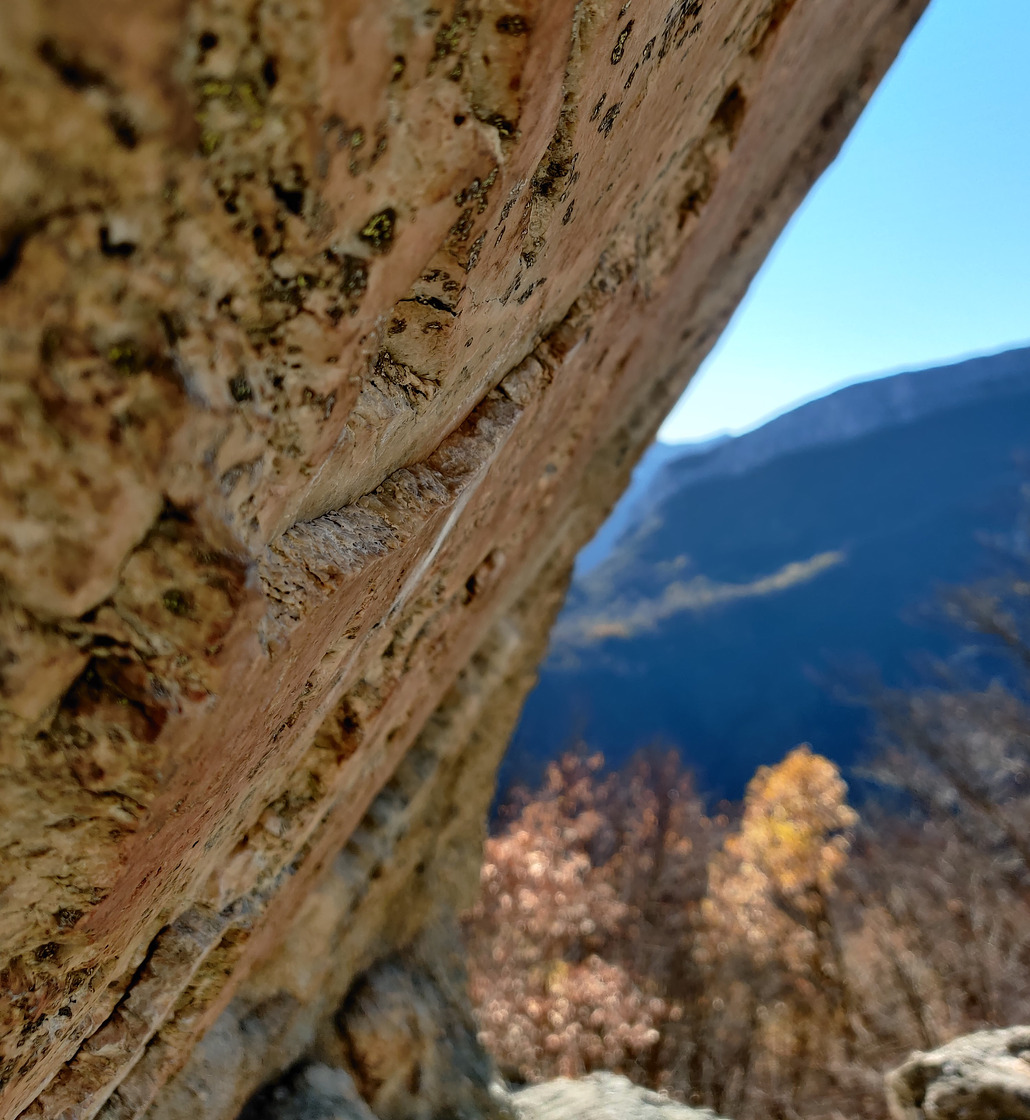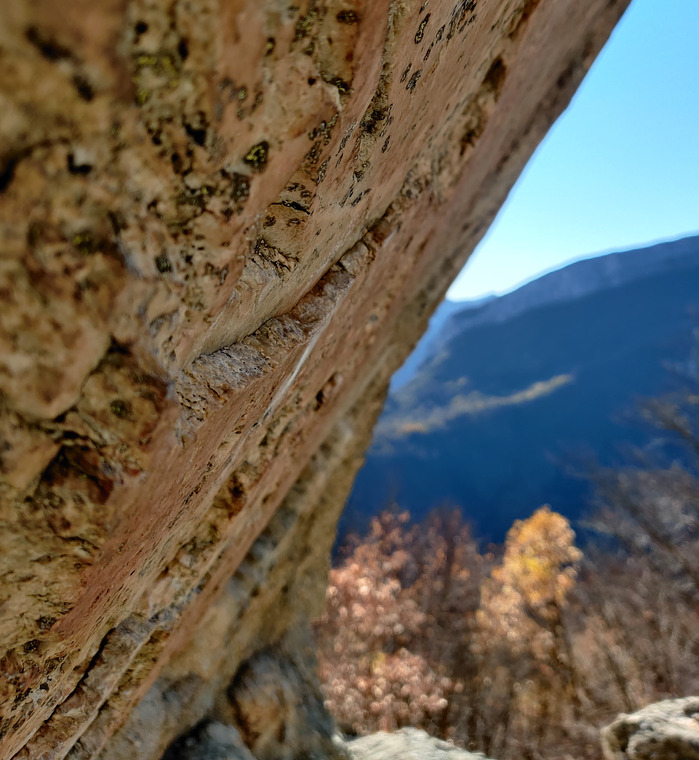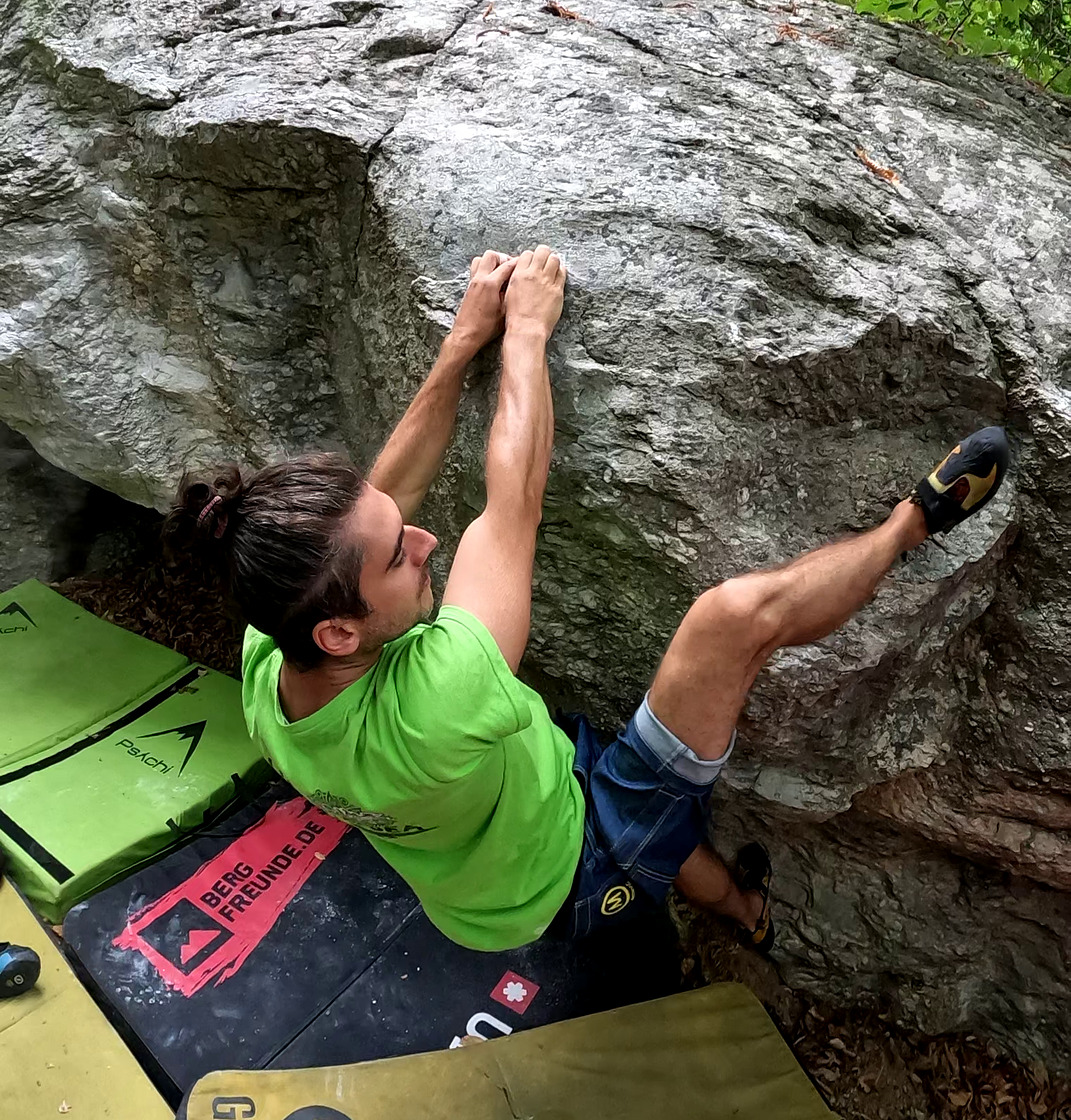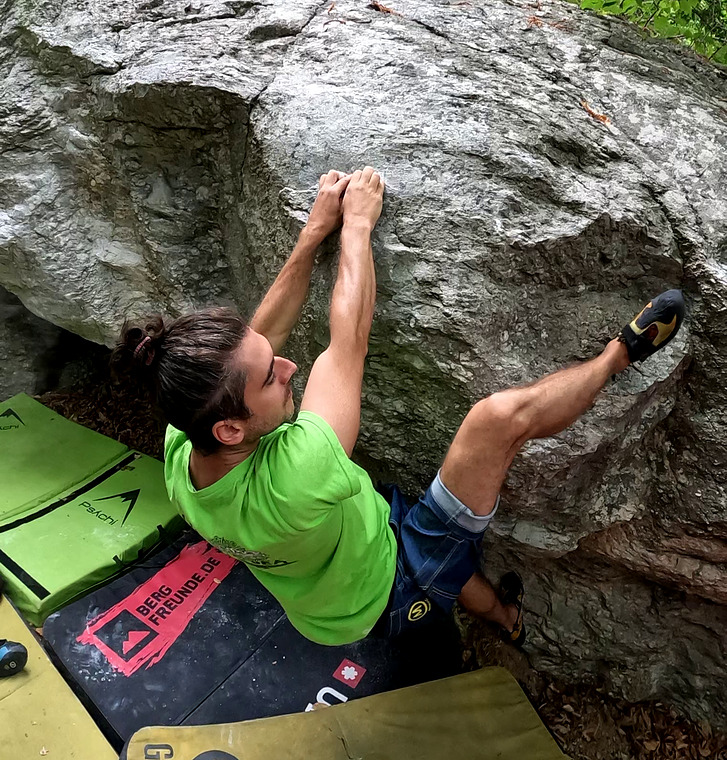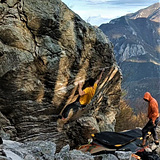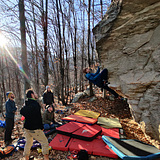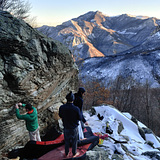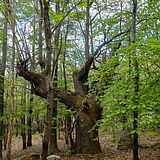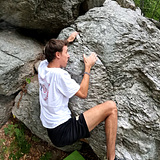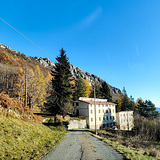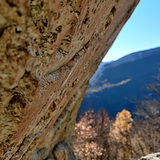☀️SUN DURING THE DAY: From morning to afternoon, but on the green seasons many boulders are in the shadow of the wood
🧭EXPOSURE: S
📆BEST PERIOD:
Winter is the best period except for big snowfalls, autumn and spring are good if it's not too hot
👪FAMILY FRIENDLY: NO, most of the boulders are on a steep slope
📵PHONE SIGNAL : NO, download the topo before going to the crag
🪨ROCK TYPE: The rock is white quartzite characterized by a lot of crystals, crimps and slopers. It's often pretty sharp and sometimes a bit slippery.
📈GRADE RANGE: From 3 to 8B+, there are also many projects to try and new boulders to climb.
🇬🇧
⛰️A few kilometers from the town of Garessio lies a beautiful valley, characterized by a forest of ancient beech and chestnut trees that creates a picturesque environment, changing with each season. The climbing sector is located at the base of rocky pinnacles that form the mountain crest, with a vast expanse of boulders scattered along the slope. The forest extends above this boulder field, offering a fully immersive experience in nature; it's not uncommon to encounter various species of wildlife, especially along the road, where it's advisable to drive carefully.
In spring and summer, the dense green foliage of the trees filters the light, providing shade on the sunniest days. In autumn and winter, after the leaves have fallen and thanks to the sector’s southern exposure, you can enjoy the warmth of the sun even on the coldest days. The climbing area is quite extensive, but thanks to the high density of boulders, the blocks are very close to each other, making approaches often very short.
The area offers various climbing styles, from sharp crimps to slopers, low traverses that can be climbed without a crashpad, and taller blocks where it's advisable to practice the top-outs using a rope first. A distinctive feature of this bouldering area is the presence of numerous relatively easy routes, making climbing accessible even for beginners. However, there are also challenges of greater difficulty, with blocks reaching up to 8B/8B+, attracting high-level climbers ready to test their skills on the valley's rock.
🇮🇹
⛰️A pochi chilometri dall'abitato di Garessio si estende una splendida valle, caratterizzata da un bosco di faggi e castagni secolari, che crea un ambiente pittoresco e mutevole in ogni stagione. Il settore si trova ai piedi di pinnacoli rocciosi che costituiscono la cresta della montagna, con una vasta distesa di massi che si estende lungo il pendio. Il bosco si sviluppa sopra questa distesa, offrendo un'esperienza di completa immersione nella natura; non è raro, infatti, incontrare animali selvatici di diverse specie, soprattutto lungo la strada, dove si raccomanda di guidare con prudenza.
In primavera ed estate, le fitte chiome verdi degli alberi filtrano la luce, creando ombra nelle giornate più soleggiate. In autunno e inverno, invece, dopo la caduta delle foglie e grazie all’esposizione a sud del settore, si può godere del calore del sole anche durante le giornate più fredde. L'area di arrampicata è piuttosto estesa, ma grazie all'alta densità di massi, i blocchi sono molto vicini tra loro, rendendo gli avvicinamenti spesso molto brevi.
L'area offre diversi stili di arrampicata, dalle piccole tacche taglienti agli svasi, dai traversi bassi scalabili senza crashpad ai blocchi più alti, dove è consigliabile provare prima le uscite usando la corda. Una caratteristica distintiva di quest'area boulder è la presenza di numerosi passaggi relativamente facili, che rendono la scalata accessibile anche a chi ha appena iniziato. Non mancano, tuttavia, sfide di maggiore difficoltà, con blocchi che raggiungono l’8B/8B+, attirando arrampicatori di alto livello pronti a sfidare la gravità sulla roccia della valle.
🇩🇪
⛰️Einige Kilometer von der Stadt Garessio entfernt erstreckt sich ein wunderschönes Tal, das von einem Wald aus uralten Buchen und Kastanien geprägt ist und in jeder Jahreszeit eine malerische Umgebung bietet. Der Klettersektor befindet sich am Fuße von Felsnadeln, die den Bergrücken bilden, mit einem weitläufigen Feld von Felsblöcken, das sich den Hang hinauf erstreckt. Der Wald erstreckt sich über dieses Felsblockfeld und bietet ein vollständig immersives Naturerlebnis; es ist nicht ungewöhnlich, dass man verschiedenen Wildtierarten begegnet, insbesondere entlang der Straße, wo es ratsam ist, vorsichtig zu fahren.
Im Frühling und Sommer filtert das dichte grüne Laub der Bäume das Licht und spendet Schatten an den sonnigsten Tagen. Im Herbst und Winter hingegen, nach dem Laubfall und dank der südlichen Ausrichtung des Sektors, kann man die Wärme der Sonne auch an den kältesten Tagen genießen. Das Klettergebiet ist ziemlich weitläufig, aber dank der hohen Dichte an Felsblöcken liegen die Blöcke sehr nahe beieinander, was die Zustiege oft sehr kurz macht.
Das Gebiet bietet verschiedene Kletterstile, von scharfen Leisten bis hin zu Slopern, niedrige Traversen, die ohne Crashpad geklettert werden können, und höhere Blöcke, bei denen es ratsam ist, die Ausstiege zuerst mit einem Seil zu üben. Ein markantes Merkmal dieses Bouldergebiets ist die Vielzahl an relativ einfachen Routen, die das Klettern auch für Anfänger zugänglich machen. Es fehlen jedoch nicht die größeren Herausforderungen, mit Blöcken, die bis zu 8B/8B+ erreichen und fortgeschrittene Kletterer anziehen, die bereit sind, ihre Fähigkeiten auf dem Fels des Tals zu testen.
🇬🇧
⏳Valdinferno has a deeply rooted history that begins in the early 1990s, thanks to the pioneers of climbing from Cuneo. The development of the area has been constant and continues to this day, with new boulders regularly discovered and cleaned.
The sector was first explored by Angelo Siri and Enrico Gallizio, who developed the "Good Morning" sector, located near the entrance to the forest. In the following years, Angelo Siri continued to explore the area, discovering traverses that could be climbed even without the use of a crashpad. Later, Marco Torielli made a significant contribution, successfully climbing several lines above the seventh grade. In the early 2000s, with the introduction of the crashpad, the possibilities for safe climbing increased, and Giovanni Massari intensified the cleaning activity, opening many unexplored lines; it was Giovanni himself who, in the following years, published the first printed guidebook of the sector.
In the following years, the area was visited by high-level climbers such as Marzio Nardi, Christian Core, and Patrick Berhault, who left their mark by opening new lines. Contributions also came from Paolo Bertolotto and Luca Macario, who, as in many other sectors of the area, significantly contributed to the development of the sector.
In recent years, with the explosion of bouldering, the sector has become increasingly popular. Of great importance was the contribution of Filippo Canavese, who has recently published updates available for free on cuneoclimbing.it. The sector is still under development, with young climbers from the Escape Climbing Garden cleaning new boulders and opening new lines.
The role of the local community is crucial for the maintenance of the area, which would otherwise quickly be overgrown with vegetation. The printed guidebook "Bouldering in Valdinferno," written by Giovanni Massari, available in online stores, has been of fundamental importance for the promotion of the sector.
🇮🇹
⏳La Valdinferno ha una storia profondamente radicata che inizia nei primi anni '90, grazie ai pionieri dell’arrampicata cuneese. Lo sviluppo dell'area è stato costante e continua ancora oggi, con nuovi blocchi scoperti e puliti regolarmente.
Il settore è stato esplorato per la prima volta da Angelo Siri ed Enrico Gallizio, che hanno sviluppato il settore Good Morning, situato vicino all'ingresso del bosco. Negli anni successivi, Angelo Siri ha continuato a esplorare la zona, scoprendo traversi scalabili anche senza l’uso del crashpad. Successivamente, Marco Torielli ha dato un contributo significativo, riuscendo a scalare diverse linee oltre il settimo grado. All'inizio degli anni 2000, con l'introduzione del crashpad, le possibilità di scalare in sicurezza sono aumentate, e Giovanni Massari ha intensificato l'attività di pulizia, liberando molte linee rimaste inesplorate; sarà proprio Giovanni, negli anni successivi, a pubblicare la prima guida cartacea del settore.
Negli anni seguenti, l'area è stata visitata da scalatori di alto livello come Marzio Nardi, Christian Core e Patrick Berhault, che hanno lasciato il segno liberando nuove linee. Non sono mancati contributi anche da parte di Paolo Bertolotto e Luca Macario, che, come negli altri settori della zona, hanno dato un apporto significativo allo sviluppo dell'area.
Negli ultimi anni, con l’esplosione del bouldering, il settore è diventato sempre più popolare. Di grande importanza è stato il contributo di Filippo Canavese, che negli ultimi tempi ha pubblicato aggiornamenti disponibili gratuitamente su cuneoclimbing.it. Il settore è tuttora in fase di sviluppo, con i giovani arrampicatori dell'Escape Climbing Garden che stanno pulendo nuovi massi e liberando nuove linee.
Il ruolo della comunità locale è cruciale per il mantenimento dell'area, che altrimenti verrebbe rapidamente ricoperta dalla vegetazione. Di fondamentale importanza per la promozione del settore è stata la guida cartacea "Bouldering a Valdinferno" scritta da Giovanni Massari, disponibile anche negli store online.
🇩🇪
⏳Die Valdinferno hat eine tief verwurzelte Geschichte, die in den frühen 1990er Jahren beginnt, dank der Pioniere des Kletterns aus Cuneo. Die Entwicklung des Gebiets war kontinuierlich und setzt sich bis heute fort, wobei regelmäßig neue Blöcke entdeckt und gereinigt werden.
Der Sektor wurde erstmals von Angelo Siri und Enrico Gallizio erkundet, die den Sektor "Good Morning" entwickelten, der sich in der Nähe des Waldeingangs befindet. In den folgenden Jahren setzte Angelo Siri seine Erkundungen fort und entdeckte Traversen, die auch ohne Crashpad geklettert werden konnten. Später leistete Marco Torielli einen bedeutenden Beitrag, indem er mehrere Linien oberhalb des siebten Grades kletterte. Anfang der 2000er Jahre, mit der Einführung des Crashpads, nahmen die Möglichkeiten für sicheres Klettern zu, und Giovanni Massari intensivierte die Reinigungsarbeiten, indem er viele unerschlossene Linien freigab; es war Giovanni selbst, der in den folgenden Jahren den ersten gedruckten Führer für den Sektor veröffentlichte.
In den folgenden Jahren wurde das Gebiet von hochrangigen Kletterern wie Marzio Nardi, Christian Core und Patrick Berhault besucht, die neue Linien freigaben und somit ihre Spuren hinterließen. Beiträge kamen auch von Paolo Bertolotto und Luca Macario, die, wie in anderen Sektoren der Region, maßgeblich zur Entwicklung des Gebiets beitrugen.
In den letzten Jahren hat der Sektor mit dem Boom des Boulderns immer mehr an Beliebtheit gewonnen. Von großer Bedeutung war der Beitrag von Filippo Canavese, der in letzter Zeit Updates veröffentlicht hat, die kostenlos auf cuneoclimbing.it verfügbar sind. Der Sektor befindet sich noch in der Entwicklung, wobei junge Kletterer des Escape Climbing Garden neue Blöcke reinigen und neue Linien freigeben.
Die Rolle der lokalen Gemeinschaft ist entscheidend für die Erhaltung des Gebiets, das sonst schnell von Vegetation überwuchert würde. Der gedruckte Führer „Bouldern in Valdinferno“, geschrieben von Giovanni Massari, der auch in Online-Shops erhältlich ist, war von grundlegender Bedeutung für die Förderung des Sektors.
